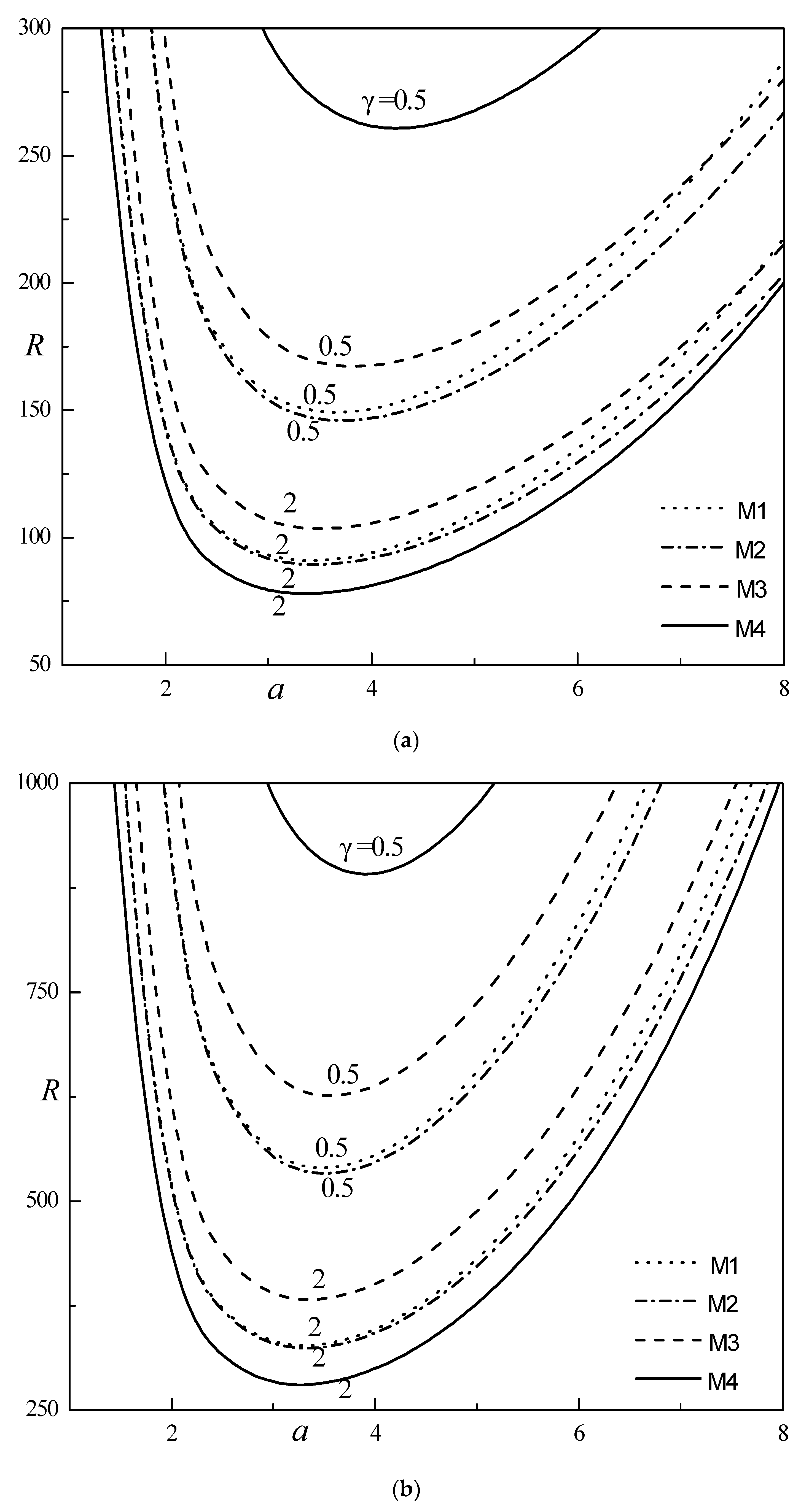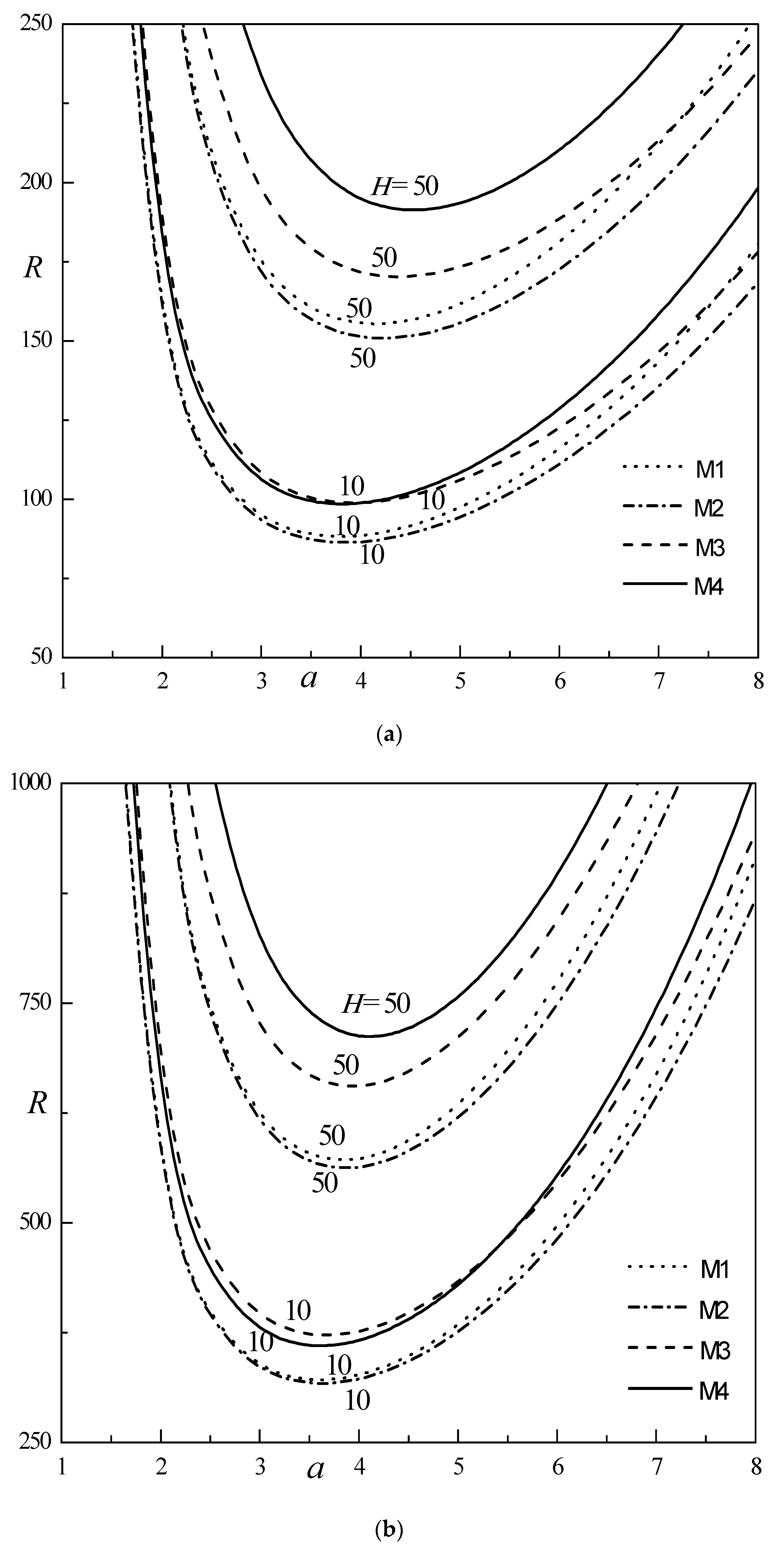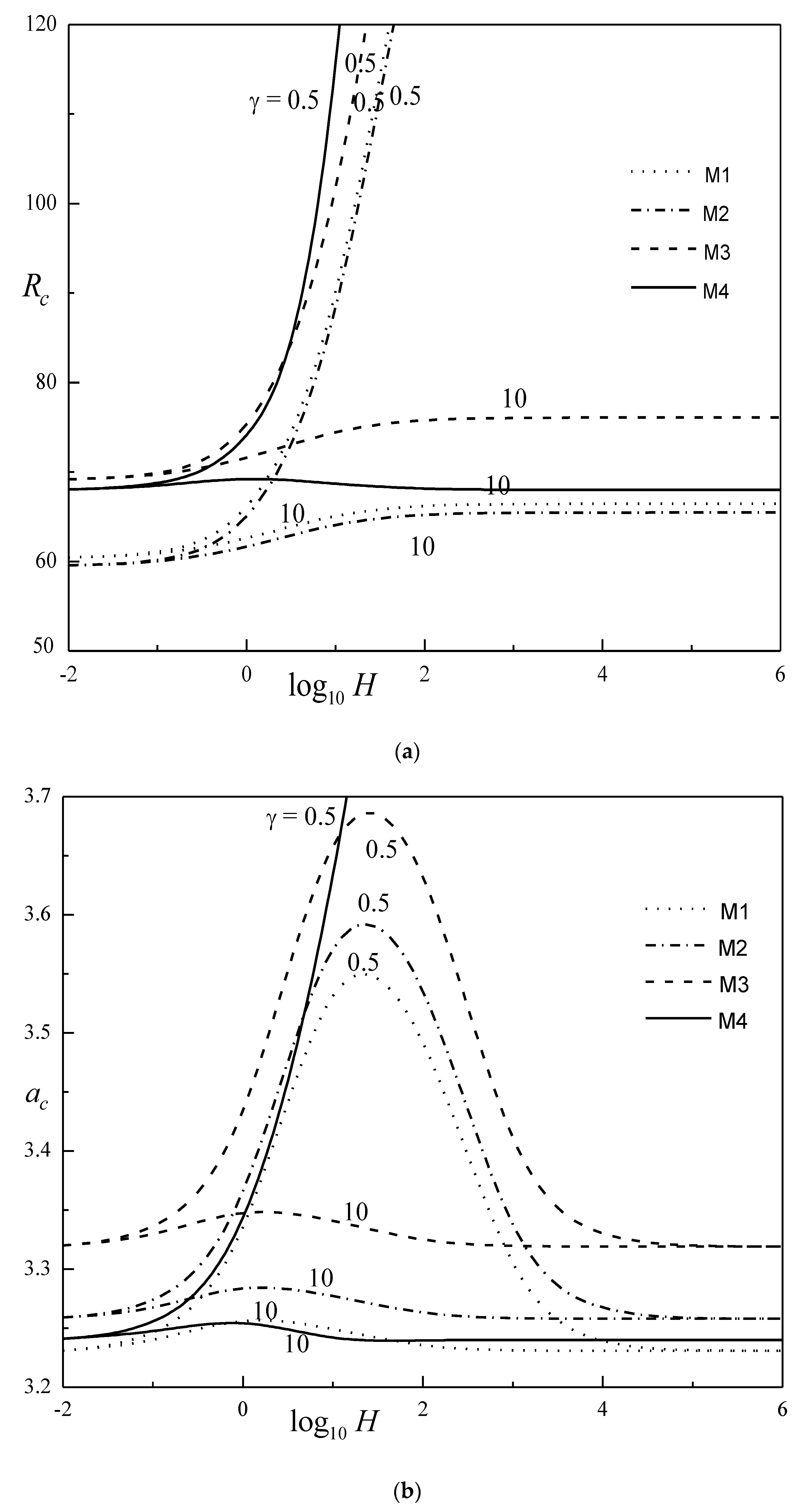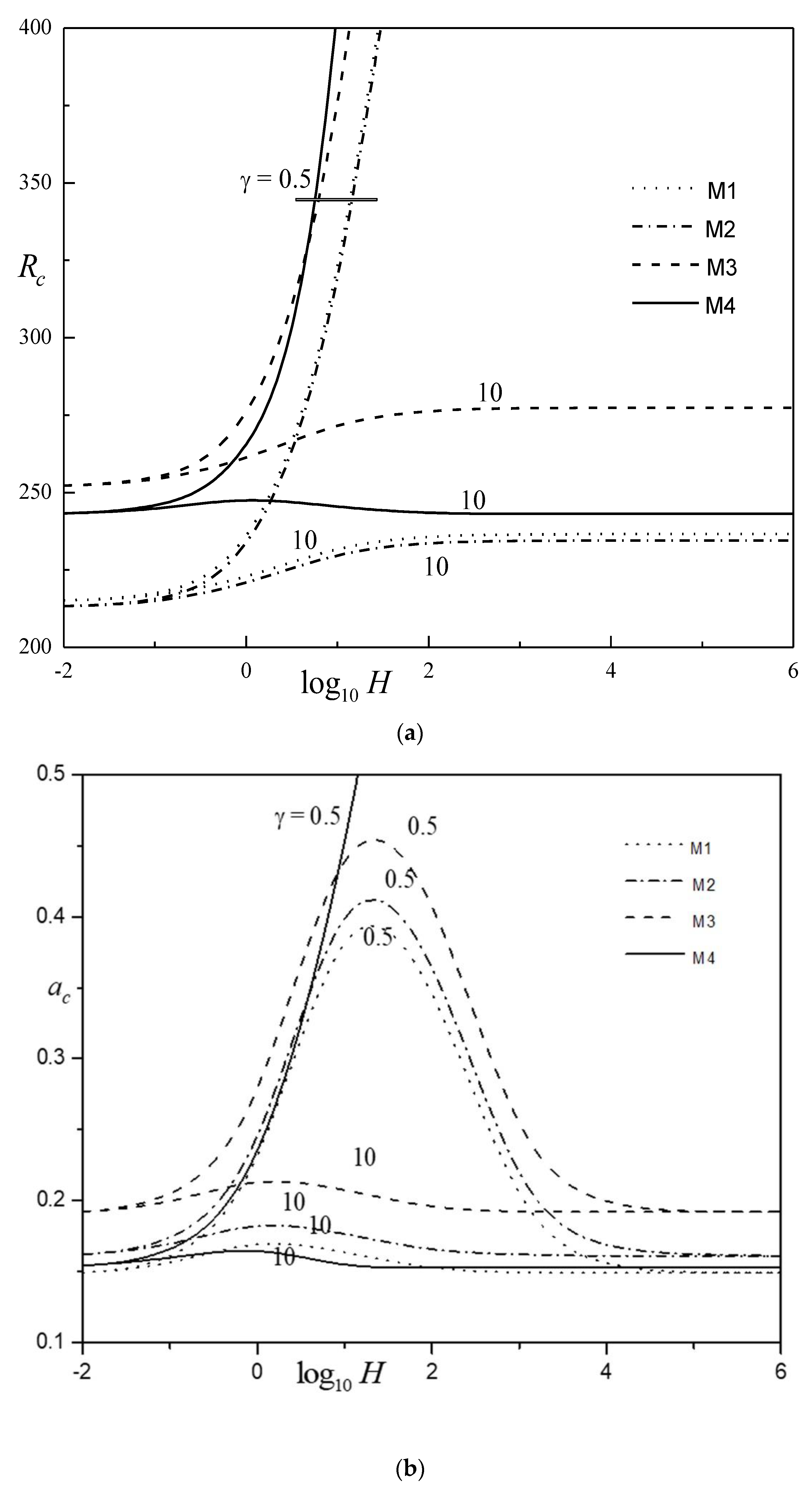The Onset of Darcy–Brinkman Convection in a Porous Layer with Mutual Impact of Thermal Non-Equilibrium and Non-Uniform Temperature Gradients
Abstract
:1. Introduction
2. Mathematical Formulation
3. Numerical Solution
4. Results and Discussion
5. Conclusions
- The system was found to be more stable for model M4 (Cubic-2 temperature profile) when compared to non-uniform temperature profiles. In particular, model M2 hastens the onset of convection.
- The porosity modified conductivity ratio has no impact on the system stability at the small- limit for all the temperature profiles considered, while for higher values, an increase in hastens the onset of convection.
- The system is found to be stable with increase in and for all the temperature profiles considered. The values of remain almost independent of at large . The values of attain the maximum for diverse values of at intermediate and remain constant at small and higher values.
- The rise in causes upsurge of the convection size, while increasing diminishes the convection cell size for all models considered.
- The is higher for model (M3) (Cubic-1 temperature profile) and least for model (M1) (linear temperature profile). The values of are unbounded growth for model (M4) at lower .
- The results for various basic temperature profiles are asymmetric quantitatively, and more importantly, they give an idea about the possibility of controlling convection using an appropriate choice for the basic temperature profile.
Author Contributions
Funding
Data Availability Statement
Acknowledgments
Conflicts of Interest
References
- Nield, D.A.; Bejan, A. Convection in Porous Media, 5th ed.; Springer: New York, NY, USA, 2017. [Google Scholar]
- Banu, N.; Rees, D.A.S. Onset of Darcy–Bénard convection using a thermal nonequilibrium model. Int. J. Heat Mass Transf. 2002, 45, 2221–2228. [Google Scholar] [CrossRef]
- Postelnicu, A. The onset of a Darcy–Brinkman convection using a thermal nonequilibrium model. Part II Int. J. Thermal Sci. 2008, 47, 1587–1594. [Google Scholar] [CrossRef]
- Postelnicu, A.; Rees, D.A.S. The onset of Darcy-Brinkman convection in a porous medium using a thermal non-equilibrium model. Part 1: Stress-free boundaries. Int. J. Energy Res. 2003, 27, 961–973. [Google Scholar] [CrossRef]
- Malashetty, M.S.; Shivakumara, I.S.; Kulkarni, S. The onset of Lapwood–Brinkman convection using a thermal non-equilibrium model. Int. J. Heat Mass Transf. 2005, 48, 1155–1163. [Google Scholar] [CrossRef]
- Straughan, B. Global non-linear stability in porous convection with a thermal non-equilibrium model. Proc. R. Soc. London 2006, 462, 409–418. [Google Scholar]
- Kumar, R.N.; Bc, P.; Gowda, R.J.P. Impact of diffusion-thermo and thermal-diffusion on the flow of Walters-B fluid over a sheet saturated in a porous medium using local thermal non-equilibrium condition. Spec. Top. Amp. Rev. Porous Media Int. J. 2023, 14, 13–26. [Google Scholar] [CrossRef]
- Shivakumara, I.S.; Mamatha, A.L.; Ravisha, M. Effects of variable viscosity and density maximum on the onset of Darcy–Bénard convection using a thermal non-equilibrium model. J. Porous Med. 2010, 13, 613–622. [Google Scholar] [CrossRef]
- Mekheimer, K.S.; Shankar, B.M.; Abo-Elkhair, R.E. Effects of Hall current and permeability on the stability of peristaltic flow. SN Appl. Sci. 2019, 1, 1610. [Google Scholar] [CrossRef]
- Prasannakumara, B.C. Assessment of the local thermal non-equilibrium condition for nanofluid flow through porous media: A comparative analysis. Indian J. Phys. 2022, 96, 2475–2483. [Google Scholar] [CrossRef]
- Rasool, G.; Ahammad, N.A.; Ali, M.R.; Shah, N.A.; Wang, X.; Shafiq, A.; Wakif, A. Hydrothermal and mass aspects of MHD non-Darcian convective flows of radiating thixotropic nanofluids nearby a horizontal stretchable surface: Passive control strategy. Case Stud. Therm. Eng. 2023, 42, 102654. [Google Scholar] [CrossRef]
- Hasan, A.A.; Mekheimer, K.S.; Tantawy, B.E. Magnetogravitodynamic Stability of Three Dimensional Streaming Velocities of Fluid Cylinder under the Effect of Capillary Force. Res. J. Appl. Sci. Eng. Technol. 2018, 15, 174–181. [Google Scholar] [CrossRef]
- Eswaramoorthi, S.; Loganathan, K.; Faisal, M.; Botmart, T.; Shah, N.A. Analytical and numerical investigation of Darcy-Forchheimer flow of a nonlinear-radiative non-Newtonian fluid over a Riga plate with entropy optimization. Ain. Shams Eng. J. 2023, 14, 101887. [Google Scholar] [CrossRef]
- Franchi, F.; Lazzari, B.; Nibbi, R.; Straughan, B. Uniqueness and decay in local thermal non-equilibrium double porosity thermos elasticity. Math. Methods Appl. Sci. 2018, 41, 6763–6771. [Google Scholar] [CrossRef]
- Fetecau, C.; Shah, N.A.; Vieru, D. General solutions for hydromagnetic free convection flow over an infinite plate with Newtonian heating, mass diffusion and chemical reaction. Commun. Theor. Phys. 2017, 68, 768. [Google Scholar] [CrossRef]
- Ravisha, M.; Shivakumara, I.S.; Mamatha, A.L. Cattaneo–LTNE porous ferroconvection. Multidiscip. Model. Mater. Struct. 2019, 15, 779–799. [Google Scholar]
- Hema, M.; Shivakumara, I.S.; Ravisha, M. Double diffusive LTNE porous convection with Cattaneo effects in the solid. Heat Transf. 2020, 49, 3613–3629. [Google Scholar] [CrossRef]
- Alsulami, M.D.; Naveen Kumar, R.; Punith Gowda, R.J.; Prasannakumara, B.C. Analysis of heat transfer using Local thermal non-equilibrium conditions for a non-Newtonian fluid flow containing Ti6Al4V and AA7075 nanoparticles in a porous media. ZAMM-J. Appl. Math. Mech. Z. Für Angew. Math. Mech. 2023, 103, e202100360. [Google Scholar] [CrossRef]
- Mehryan, S.A.M.; Ghalambaz, M.; Chamkha, A.J.; Izadi, M. Numerical study on natural convection of Ag–MgO hybrid/water nanofluid inside a porous enclosure: A local thermal non-equilibrium model. Powder Technol. 2020, 367, 443–455. [Google Scholar] [CrossRef]
- Sarada, K.; Gowda, R.J.P.; Sarris, I.E.; Kumar, R.N.; Prasannakumara, B.C. Effect of Magnetohydrodynamics on Heat Transfer Behaviour of a Non-Newtonian Fluid Flow over a Stretching Sheet under Local Thermal Non-Equilibrium Condition. Fluids 2021, 6, 264. [Google Scholar] [CrossRef]
- Shyabal, S.; Ravisha, M.; Hanumagowda, B.N.; Mamatha, A.L.; Shivakumara, I.S. Onset of LTNE anisotropic porous convection: Effect of asymmetric temperature boundary conditions. Eur. Phys. J. Plus 2023, 138, 106. [Google Scholar] [CrossRef]
- Capone, F.; Gianfrani, J.A. Onset of convection in LTNE Darcy-Brinkman anisotropic porous layer: Cattaneo effect in the solid. Int. J. Nonlinear Mech. 2022, 139, 103889. [Google Scholar] [CrossRef]
- Nield, D.A. The onset of transient convective instability. J. Fluid Mech. 1975, 71, 441–454. [Google Scholar] [CrossRef]
- Rudraiah, N.; Vecrappa, B.; Balachandra Rao, S. Effects of nonuniform thermal gradient and adiabatic boundaries on convection in porous media. J. Hcut. Trmfcr. 1980, 102, 154–260. [Google Scholar] [CrossRef]
- Vasseur, P.; Robillard, L. The Brinkman model for natural convection in a porous layer: Effects of nonuniform thermal gradient. Int. J. Heat Mass Transf. 1993, 36, 4199–4206. [Google Scholar] [CrossRef]
- Degan, G.; Vasseur, P. Influence of anisotropy on convection in porous media with nonuniform thermal gradient. Int. J. Heat Mass Transf. 2003, 46, 781–789. [Google Scholar] [CrossRef]
- Idris, R.; Othman, H.; Hashim, I. On effect of non-uniform basic temperature gradient on Bénard–Marangoni convection in micropolar fluid. Int. Commun. Heat Mass Transf. 2009, 36, 255–258. [Google Scholar] [CrossRef]
- Shivakumara, I.; Lee, J.; Vajravelu, K.; Mamatha, A. Effects of thermal nonequilibrium and non-uniform temperature gradients on the onset of convection in a heterogeneous porous medium. Int. Commun. Heat Mass Transf. 2011, 38, 906–910. [Google Scholar] [CrossRef]
- Lee, J.; Shivakumara, I.S.; Mamatha, A.L. Effect of non-uniform temperature gradients on thermo-gravitational convection in a porous layer using a thermal non-equilibrium model. J. Porous Med. 2011, 14, 659–669. [Google Scholar] [CrossRef]
- Hamid, N.Z.A.; Mokhtar, N.F.M.; Arifin, N.M.; Sathar, M.H.A. Effect of Nonlinear Temperature Profile on Thermal Convection in a Binary Fluid Saturated an Anisotropic Porous Medium. J. Adv. Res. Fluid Mech. Ther. Sci. 2019, 56, 43–58. [Google Scholar]





Disclaimer/Publisher’s Note: The statements, opinions and data contained in all publications are solely those of the individual author(s) and contributor(s) and not of MDPI and/or the editor(s). MDPI and/or the editor(s) disclaim responsibility for any injury to people or property resulting from any ideas, methods, instructions or products referred to in the content. |
© 2023 by the authors. Licensee MDPI, Basel, Switzerland. This article is an open access article distributed under the terms and conditions of the Creative Commons Attribution (CC BY) license (https://creativecommons.org/licenses/by/4.0/).
Share and Cite
Shyabal, S.; Hanumagowda, B.N.; Ravisha, M.; Mamatha, A.L.; Shivaraju, N.; D. O., S.; Alkarni, S.; Shah, N.A. The Onset of Darcy–Brinkman Convection in a Porous Layer with Mutual Impact of Thermal Non-Equilibrium and Non-Uniform Temperature Gradients. Symmetry 2023, 15, 1695. https://doi.org/10.3390/sym15091695
Shyabal S, Hanumagowda BN, Ravisha M, Mamatha AL, Shivaraju N, D. O. S, Alkarni S, Shah NA. The Onset of Darcy–Brinkman Convection in a Porous Layer with Mutual Impact of Thermal Non-Equilibrium and Non-Uniform Temperature Gradients. Symmetry. 2023; 15(9):1695. https://doi.org/10.3390/sym15091695
Chicago/Turabian StyleShyabal, Suma, B. N. Hanumagowda, M. Ravisha, A. L. Mamatha, N. Shivaraju, Soumya D. O., Shalan Alkarni, and Nehad Ali Shah. 2023. "The Onset of Darcy–Brinkman Convection in a Porous Layer with Mutual Impact of Thermal Non-Equilibrium and Non-Uniform Temperature Gradients" Symmetry 15, no. 9: 1695. https://doi.org/10.3390/sym15091695
APA StyleShyabal, S., Hanumagowda, B. N., Ravisha, M., Mamatha, A. L., Shivaraju, N., D. O., S., Alkarni, S., & Shah, N. A. (2023). The Onset of Darcy–Brinkman Convection in a Porous Layer with Mutual Impact of Thermal Non-Equilibrium and Non-Uniform Temperature Gradients. Symmetry, 15(9), 1695. https://doi.org/10.3390/sym15091695




